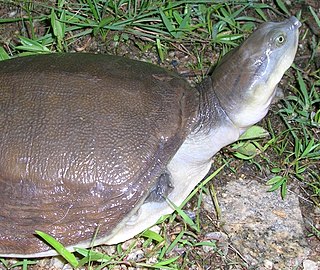Related Research Articles

Lissemys is a genus of softshell turtles in the subfamily Cyclanorbinae of the family Trionychidae. The genus is indigenous to southern Asia.

Ailuravus is a genus of prehistoric rodents in the family Ischyromyidae.
Acantholytoceras is an extinct genus of cephalopod belonging to the ammonite subclass.
Anfaceras is an extinct genus of cephalopods belonging to the Ammonite subclass.
Anisarcestes is an extinct genus of cephalopod belonging to the Ammonite subclass.
Argosirenites is an extinct genus of cephalopods belonging to the Ammonite subclass.

Fossilworks was a portal which provides query, download, and analysis tools to facilitate access to the Paleobiology Database, a large relational database assembled by hundreds of paleontologists from around the world.
Tetraconodon was an extinct genus of even-toed ungulates that existed during the middle and late Miocene in Asia.
Hemichoerus was an extinct genus of even-toed ungulates that existed during the Miocene in Europe.
Potamochoeroides was an extinct genus of even-toed ungulates that existed during the Pliocene in South Africa.
Namachoerus was an extinct genus of even-toed ungulates that existed during the Miocene of Africa.

Hippopotamodon is a genus of extinct suid even-toed ungulates that existed during the Miocene to the Pleistocene in Europe and Asia.
Korynochoerus is an extinct genus of even-toed ungulates that existed during the Miocene in Europe and Asia Minor.
Stylochoerus is an extinct genus of suid that existed during the Pleistocene in Ethiopia.
Hyosus was an extinct genus of even-toed ungulates that existed in India.
Kenyasus is an extinct genus of suid that existed in Africa during the Miocene.
Schizochoerus was an extinct genus of even-toed ungulates that existed in Asia Minor during the Miocene.
References
- ↑ "Fossilworks: Anatibetites kelvini". fossilworks.org. Retrieved 17 December 2021.
- ↑ "Late Triassic and Early Jurassic Ammonoids from Eastern Himalayas". www.geology.com.cn. Retrieved 2019-03-10.
- ↑ "PBDB". Paleobiology Database . Retrieved 2019-03-10.
- ↑ "Fossilworks: Gateway to the Paleobiology Database". paleodb.org. Retrieved 2019-03-10.